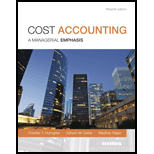
1.
To compute: Projected net income for 2014.
Given information:
Selling price per unit is $35.
Variable cost per unit is $18.50.
Fixed costs are $214,500.
Units to be sold are 22,000 units.
Tax rate is 40%.
2.
To compute: Break-even points in units.
Given information:
Selling price per unit is $35.
Variable cost per unit is $18.50.
Fixed costs are $214,500.
3.
To compute: Net income for 2015.
Given information:
Selling price per unit is $35.
Variable cost per unit is $18.50.
Revenue target is $875,000 or 25,000 bowls
Fixed costs are
Tax rate is 40%.
4.
To compute: Break-even points in units for 2015.
Given information:
Selling price per unit is $35.
Variable cost per unit is $18.50.
Fixed costs are
5.
To compute: Budgeted revenue for 2015.
Given information:
Selling price per unit is $35.
Variable cost per unit is $18.50.
Fixed costs are
Net income is equal to the net income of 2017 which is $89,100.
Tax rate is 40%.
6.
To compute: Break-even points in units for 2015.
Given information:
Selling price per unit is $35.
Variable cost per unit is $18.50.
Fixed costs are
Net income is $108,450.
Expected sales are 25,000 units.
Tax rate is 40%.
Want to see the full answer?
Check out a sample textbook solution
Chapter 3 Solutions
Cost Accounting, Student Value Edition (15th Edition)

 AccountingAccountingISBN:9781337272094Author:WARREN, Carl S., Reeve, James M., Duchac, Jonathan E.Publisher:Cengage Learning,
AccountingAccountingISBN:9781337272094Author:WARREN, Carl S., Reeve, James M., Duchac, Jonathan E.Publisher:Cengage Learning, Accounting Information SystemsAccountingISBN:9781337619202Author:Hall, James A.Publisher:Cengage Learning,
Accounting Information SystemsAccountingISBN:9781337619202Author:Hall, James A.Publisher:Cengage Learning, Horngren's Cost Accounting: A Managerial Emphasis...AccountingISBN:9780134475585Author:Srikant M. Datar, Madhav V. RajanPublisher:PEARSON
Horngren's Cost Accounting: A Managerial Emphasis...AccountingISBN:9780134475585Author:Srikant M. Datar, Madhav V. RajanPublisher:PEARSON Intermediate AccountingAccountingISBN:9781259722660Author:J. David Spiceland, Mark W. Nelson, Wayne M ThomasPublisher:McGraw-Hill Education
Intermediate AccountingAccountingISBN:9781259722660Author:J. David Spiceland, Mark W. Nelson, Wayne M ThomasPublisher:McGraw-Hill Education Financial and Managerial AccountingAccountingISBN:9781259726705Author:John J Wild, Ken W. Shaw, Barbara Chiappetta Fundamental Accounting PrinciplesPublisher:McGraw-Hill Education
Financial and Managerial AccountingAccountingISBN:9781259726705Author:John J Wild, Ken W. Shaw, Barbara Chiappetta Fundamental Accounting PrinciplesPublisher:McGraw-Hill Education





